The Longest Journey: An Interview with Rick Smolan
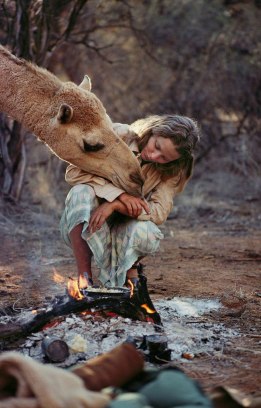
Robyn Davidson’s solo trek across Australia with camels was a turning point in Rick Smolan’s career as a photographer. © 2014 Rick Smolan, Against All Odds Productions II
By any standards, Rick Smolan has an impressive resumé. As a photographer, he has shot for TIME , Newsweek , and National Geographic . As a book editor, he created the bestselling A Day in the Life series of photobooks, which broke the mold of traditional publishing and established a new model of sponsored, self-published books. He has gone on to innovate in other ways, publishing customizable books and creating television specials and apps.
But, talking to Smolan, it becomes clear why he named his company Against All Odds Productions. He is nothing if not ambitious, and his projects often teeter on the brink, depending on last-minute arrangements and mountains of goodwill. “Sometimes, I don’t know what I want, only what I don’t want,” he admits. “So we keep coming back at it. But it seems to pay off in the end.”
Recently, Smolan logged another first: he saw himself reflected through a Hollywood lens when his first book, From Alice to Ocean , was used as partial basis for Tracks , a movie starring Mia Wasikowska and Adam Driver. As a young National Geographic photographer, Smolan had spent three months with Robyn Davidson, an Australian who, in 1977, embarked on an epic nine-month trek across the Australian Outback with a team of four camels and a dog. Davidson’s book about the journey, Tracks , became a huge bestseller, and the filmmakers used this and Smolan’s images in From Alice to Ocean as inspiration.
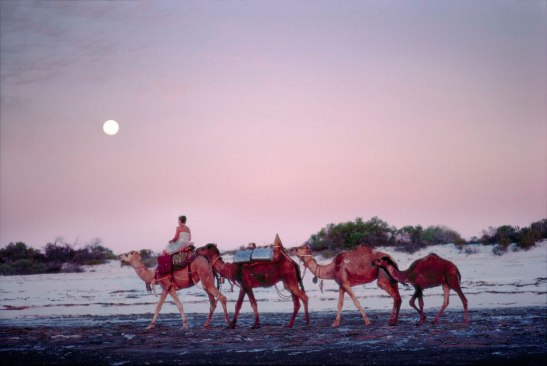
Rick Smolan’s beautiful 1977 images of Robyn Davidson in the Australian Outback inspired the visual tone of the movie Tracks. © 2014 Rick Smolan, Against All Odds Productions II
A lush, thought-provoking movie, Tracks has everything, Smolan says: “It’s an adventure story, a love story, a dog story.” On the course of the trek, he and Davidson began a romance that, he says, inspired his onward career. “It was a turning point for me as a photographer. Being able to go back again and again, to keep coming at the story, and to have so much time to just look at things and think–as Robyn kept telling me to do–was crucial to who I became.”
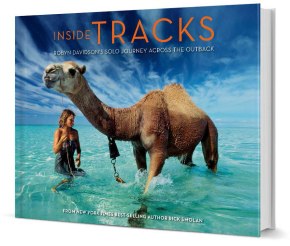 Now, Smolan has published a companion book,
Inside Tracks
, featuring his original photographs alongside stills from the movie and essays by him and Davidson. Ever the innovator, he has included a cool new feature in the book: viewers can download a free app that, when pointed at certain images, plays associated clips from the movie.
Now, Smolan has published a companion book,
Inside Tracks
, featuring his original photographs alongside stills from the movie and essays by him and Davidson. Ever the innovator, he has included a cool new feature in the book: viewers can download a free app that, when pointed at certain images, plays associated clips from the movie.
Last week, Smolan invited The Literate Lens to his New York office, where we spoke about trekking across Australia, creating a new publishing model and returning to his first major story after three decades.
So what’s it like to see yourself as a movie character?
Very surreal! What’s really amazing is that not only did they cast Mia and Adam to look like Robyn and me, but they re-created the clothes we were wearing, even down to Adam’s granny glasses. One day I was talking to Mia while she was waiting on set, and she told me the costume designer had looked at my images and manufactured a replica blouse. Given that these are the guys who made The King’s Speech , I shouldn’t be surprised. Even so, it seemed remarkable. And the other thing that was really fun, as a photographer, was watching my still photographs literally come to life.
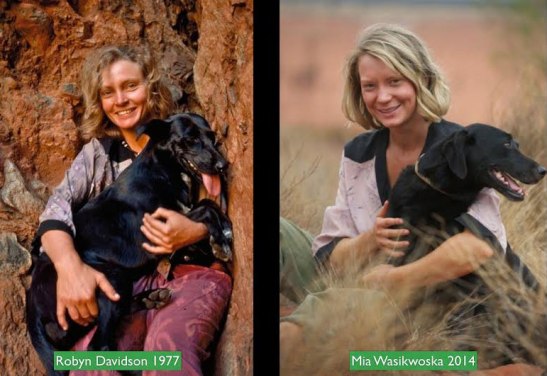
The filmmakers were meticulous about recreating Smolan’s images, even down to replicating a vintage blouse. © 2014 Rick Smolan, Against All Odds Productions II
In the movie, “Rick” is pretty clueless and intrusive, at least at the beginning. Was that accurate?
Not entirely. I don’t set up pictures. I tend to blend into the background: the last thing I’d do is say, Turn your shoulders back, tilt your head, smile. And I never photographed a secret Aboriginal grieving ceremony, as they have me do in the movie. I had discussions with the filmmakers beforehand, and I said, I hope you guys won’t do the thing Hollywood always does with photographers, which is to make them vultures. And of course, the first time I saw the movie, I went, Oh fuck, really? That was the one thing I asked you not to do. But they were upfront about it. They said, Yes, we know we played into the stereotype. But we needed to make Rick irritating at the beginning, so the character had an arc. If you were just a nice guy throughout, it wouldn’t be interesting. Ultimately, their hearts were in the right place. And I think they were really caught up in Robyn’s book.

National Geographic had turned Robyn down the first time she wrote to them for support. But with Rick’s encouragement, she wrote again and secured $4,000 for her trip. © 2014 Rick Smolan, Against All Odds Productions II
But there was real tension between you and Robyn about your mission versus hers, right? She saw your images as selling out in some way? Even at the end, she asked, “What now? Are you going to go back to being a prostitute?”
Right. Early on, she was critical of journalists who parachuted into Alice Springs to do stories on the Aborigines, and she basically lumped me in with them. And I said to her, If this is a contest about who cares the most, you win, because I just got here and I’m still learning about this. I’d actually spent several months living on the Pine Ridge Indian reservation during a shootout by the FBI, and I’d made friends there, so I was pretty aware of what my country has done to our native population. So I said, Don’t just assume that because I’m taking pictures that I’m feeding off of them. But I would never have said, as they have me say in the movie, If it wasn’t for National Geographic you wouldn’t be here. Robyn’s very resourceful, she would have found a way to go on the trip anyway.
How did those feelings of resentment and disdain morph into a romance?
She was resentful at the beginning because of what I represented, which was that in a moment of weakness she’d asked for help and money. She’d been determined to do this trip alone: she wouldn’t let any friends come, and then suddenly she was stuck with this guy who was smitten with her, which made it even worse. Of course I fell madly in love with her because she hated me—funny how that always works! She got to like me more as time went on. But I was actually relieved that they played down the romance in the movie, because I think it wouldn’t have been such a strong movie if they’d turned it into Out of Africa .
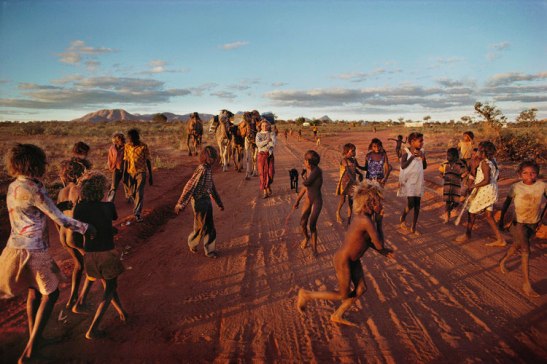
The children of Docker River greet Robyn (“the camel lady”) with great excitement. © 2014 Rick Smolan, Against All Odds Productions II
What was it like reading the book she published two years after the trip?
She called and said she’d written this book, and wanted me to read it before it went to press, because she wasn’t very nice to me in it. I guess she was nervous. So she sent it, I read it, and I said, I think it’s fine. And she said, you don’t want to change anything ? I said, well, you know, I’m an asshole at the beginning of the book, and I get better, and that’s a good trajectory—better than the opposite. And I think anybody reading the book will get a sense of who you are. It’s your story: I’m not going to edit it or censor it. Her writing is hypnotic; you get sucked in to the reality of this young woman. In addition to being an adventurer, she turned out to be this incredible writer.
Through the movie, you’ve come back to the book and images after thirty-some years. What’s it been like to encounter them after that passage of time?
I think that as a photographer or subject, when you look at a picture shot in the recent past, it’s really hard not to fall into a memory of what you were doing and thinking when it was shot. So you can’t stop at the picture, you fall through that window. But now, because so many years have gone by, it was really fun going back. With a lot of the pictures, I don’t remember shooting them, so I can look at them as if I’m an editor and not the photographer. And Robyn didn’t like the pictures at all back then: she thought they glamorized her (“You made me look like a goddamn model,” she said). Now, though, she loves them.
What are some of your favorite images in the new book?
I love the one [above] of her walking to Docker River with all the children dancing around her. There’s a picture of a ghost gum tree late in the day, these red branches lit up by the setting sun. And there’s one of Aboriginal children jumping with a balloon: that one has an interesting backstory. I had two cameras: one camera set for Tri-X 400 ASA, and the other for Kodachrome 64 ASA. One day I mistakenly put color in the black-and-white camera. I saw these kids playing with the balloon, got that frame, and knew it was one of the best pictures I’d ever shot. Then I looked down and I realized I’d underexposed it by five stops. This was Kodachrome, which gives you maybe a quarter of a stop margin, half a stop if you’re lucky. When it was developed, that frame was so dark you could barely see it. And I was so heartbroken that I stuck it in a safe-deposit box in 1978—then when we did this book, I pulled it out and called a friend at Adobe, and said, Is there any way you could save this? And they did—which makes me love it even more. I can’t believe I actually had the wherewithal, as a kid, to think, Someday they’ll have a way to fix this. I just couldn’t bear to throw it away.
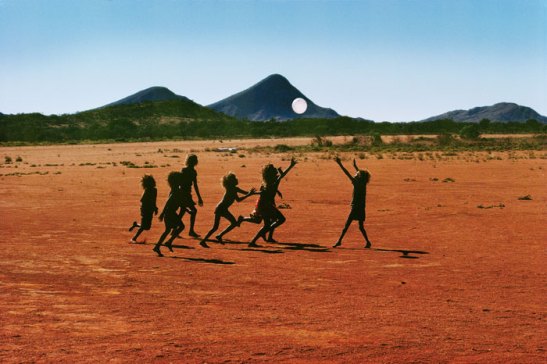
After three decades, this underexposed image was restored and included in Inside Tracks. © 2014 Rick Smolan, Against All Odds Productions II
That’s a great story. You talked before about seeing still photographs come to life, and in the book you have a feature where people can download the app Aurasma, point their smartphone at an image and it shows the scene from the movie based on the image. How did you get the idea to do that?
I heard about Aurasma’s technology and called them. They thought it was an interesting project and agreed to help. The app, which is free, has been out for a couple of years: it’s mostly used by advertisers, to show sneakers and the like. It’s a bit like those newspapers in Harry Potter, where you tap an image and the person turns around and tells you their story. We also used it for our 2012 book, The Human Face of Big Data . You can tap on people in that book and see their TED talks.
You’ve always been an innovator with your book projects, starting with the A Day in the Life series. How did that all get started?
After the camel trip I stayed in Australia, and after Robin’s “prostitute” comment, my response was to look for a story to show her she was wrong. I did a story on children fathered by American GIs and abandoned, and got very involved: there was one girl, Natasha, who I arranged for friends of mine to adopt. I spent a year on the story, then couldn’t get it published because no American publication wanted to do a story about illegitimate children of American GIs. But there was a German magazine that had been doing some hard-hitting stories, and they wanted it. I’d had a grandiose idea that I’d send a copy to every congressperson and newspaper in the country, because I was trying to make a difference. But the magazine ended up castrating the story because they were worried about ad sales, and I took my name off it: it ran uncredited, and was useless.

Smolan with Un-Sok Kim, an Amerasian girl fathered by an American GI. She was adopted by friends of his; he told her story in his book Natasha’s Story.
I realized that however good my photographs were, I’d always be inside someone else’s machine unless I struck out on my own. Then I was sitting at a bar with a bunch of photographers in Bangkok: there was Philip Jones-Griffiths, J. P. Laffont, David Burnett, all friends and mentors, and I said, Wouldn’t it be nice for once to get rid of all these editors and do it ourselves, nobody but us? What if we did A Day in the Life of Australia? I was the baby of the group, and they all patted me on the head and said, Yeah, kid, you go ahead and organize it.
Out of necessity, yes. First I met with publishers, who all told me what a stupid idea it was. Thirty-five publishers said no. But I knew the Prime Minister of Australia, Malcolm Fraser, so I got an appointment with him and asked him to help. He said he couldn’t fund it, but would set up meetings for me with the CEO of Quantas, the CEO of Kodak in Australia, Steve Jobs, and others, and I could ask them for airline tickets, computers, film, hotel rooms, rental cars. I said I couldn’t do that, it would be selling out. Nobody did sponsored books back then! But Fraser said it would be like PBS television, I would just say, This book was made possible by… So I did it. I had no money to pay the photographers: we had families put them up all over Australia. It was incredibly stressful. We had 20 people in sleeping bags in our office, and everyone was hysterical all the time. We did everything wrong. I hired a designer who I fired half way through because his design felt like a confusing mishmash. While we were on press, I reached out to my brilliant younger sister Leslie (Smolan), who flew to Japan on a day’s notice and redesigned the entire book, creating the look and feel of what went on to become a series of award-winning books. Then the book came out, and people went nuts: this self published book became the number one book in Australia. It sold 250,000 copies immediately. It’s so funny, because if a publisher had said yes to me I’d have gotten $1 a book and been screwed like every other photographer who does a photo book. But by having them say no, I actually came up with a whole other business model.
And you went on to do many other books, on countries and on themes.
Yes, though that wasn’t the initial plan. I thought I’d go back to being a photographer, but then the governor’s office of Hawaii called and said, the governor was just in Australia and saw your book, and our anniversary of statehood is coming up, would you do a book on us? And American Express called and said, we want to do a book about Japan because we’re fighting with the JCB card there, and we love your book. My friend David Cohen came on board as my partner for the ongoing Day in the Life series, as we kept saying to these people, You’ll have no editorial control, we’re not going to do any product placement, then TIME and Newsweek started fighting over who was going to put us on the cover. The whole thing was so weird! To go from everyone saying, What a stupid idea, to being on the cover of the world’s biggest newsweeklies. And to have some of the world’s best photographers working on the projects, like Sebastiao Salgado and Jim Nachtwey.
You moved into a different role, being an editor and producer rather than a photographer. How was that?
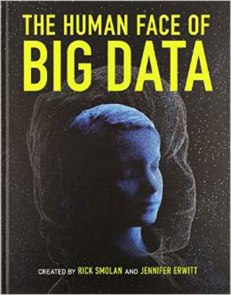 It’s funny because I’m really not a leader type, I prefer to be in the shadows. In high school, I would have been voted least likely to run anything. But this work has grown organically. I love technology, so in the first years of the Internet we did the book
24 Hours in Cyberspace
, and for Intel’s anniversary, we did a book about how silicon chips are now basically powering society. We did the global water crisis, and now we just did big data. It’s been a blast. The only thing I regret is that there are friends I didn’t invite back for subsequent projects, because although they’re great photographers they just don’t do a good job under the kind of pressure we put on them. So I became the person I always hated as a photographer, the editor who didn’t call back. I lost a bunch of friends over that, which was heartbreaking.
It’s funny because I’m really not a leader type, I prefer to be in the shadows. In high school, I would have been voted least likely to run anything. But this work has grown organically. I love technology, so in the first years of the Internet we did the book
24 Hours in Cyberspace
, and for Intel’s anniversary, we did a book about how silicon chips are now basically powering society. We did the global water crisis, and now we just did big data. It’s been a blast. The only thing I regret is that there are friends I didn’t invite back for subsequent projects, because although they’re great photographers they just don’t do a good job under the kind of pressure we put on them. So I became the person I always hated as a photographer, the editor who didn’t call back. I lost a bunch of friends over that, which was heartbreaking.
Ok, so that’s the worst thing. What’s been the best?
The very first person I invited to participate in A Day in the Life was Elliott Erwitt, who never answered my letter. Then two years later, I saw him at an exhibition and introduced myself. I said, You probably don’t know this, but you were the inspiration for the letter I sent to photographers. And while I was talking to him, his daughter Jennifer walked up. Later, I told my best friend, I met the woman I’m going to marry tonight. It was that immediate. And now we have two kids, we work together on these books, and we live in New York. And Natasha, the Korean-American girl who got adopted by my friends, has kids who have sleepovers with my kids. It’s amazing. Sometimes it’s hard for me to get my brain around all of it.
——————————————————————————————–
F U R T H E R R E S O U R C E S :
Buy Inside Tracks (currently on special offer at $27 through Amazon.com) by clicking on the cover image above, or here .
Rick Smolan’s recent talk at National Geographic:
A video about Inside Tracks by award-winning multimedia producer Brian Storm:
http://mediastorm.com/clients/inside-tracks-for-against-all-odds
Rick Smolan talks about the dangers of the Australian Outback:
7 comments on “ The Longest Journey: An Interview with Rick Smolan ”
Leave a Reply
Connecting to %s

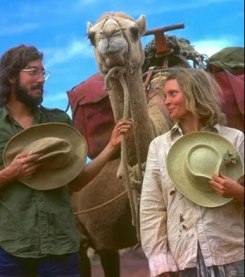
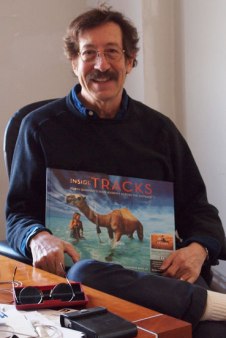
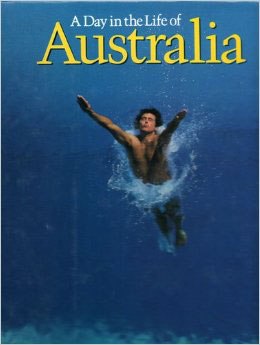



Brilliant. Totally fascinating. A great story.
This is a great post, Sarah! Rick’s a lucky guy, having met and photographed Robyn Davidson, who seems such a captivating and determined woman. Equally engaging is the part about Rick’s success, once he decides to publish on his own. Everyone’s dream!
I love the contrast between 1971 Rick, the wet-behind-the-ears photographer, and 2014 Rick, the media mogul with the power to make the careers of today’s young photographers. I guess that’s often the progression, but it’s rare that these two parts of a career make contact like they do in this piece. Definitely gives me a sense of perspective.
Thanks for this post Sarah. So fascinating to learn about how the Day in the Life books all began. As a young photographer (a long time ago) they were such an inspiration to me. I love the story about the underexposed image of the kids playing with the balloon and that Smolan was actually able to save it after all those years. I felt his pain….and joy!
Instructive and fascinating post! I never knew that the “Day in the life of..” books had such humble beginnings. I love stories like this!
Great work on a great story – NOW I’m looking for a re-issue of the software version from back then!
That’s a nice story!
————–
http://travelingrockhopper.com